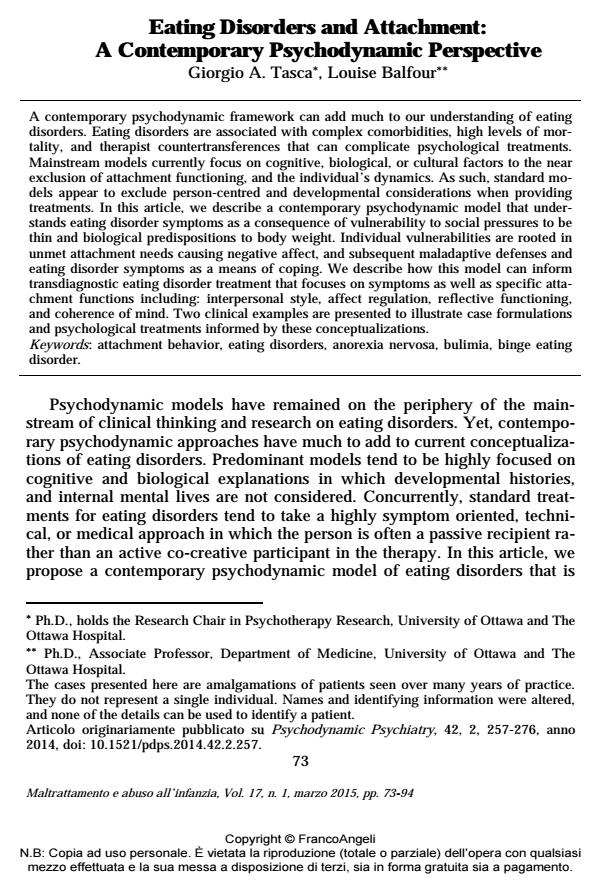Eating Disorders and Attachment: A Contemporary Psychodynamic Perspective
Journal title MALTRATTAMENTO E ABUSO ALL’INFANZIA
Author/s Giorgio A. Tasca, Louise Balfour
Publishing Year 2015 Issue 2015/1
Language English Pages 18 P. 55-72 File size 110 KB
DOI 10.3280/MAL2015-001005
DOI is like a bar code for intellectual property: to have more infomation
click here
Below, you can see the article first page
If you want to buy this article in PDF format, you can do it, following the instructions to buy download credits

FrancoAngeli is member of Publishers International Linking Association, Inc (PILA), a not-for-profit association which run the CrossRef service enabling links to and from online scholarly content.
A contemporary psychodynamic framework can add much to our understanding of eating disorders. Eating disorders are associated with complex comorbidities, high levels of mortality, and therapist countertransferences that can complicate psychological treatments. Mainstream models currently focus on cognitive, biological, or cultural factors to the near exclusion of attachment functioning, and the individual’s dynamics. As such, standard models appear to exclude person-centred and developmental considerations when providing treatments. In this article, we describe a contemporary psychodynamic model that understands eating disorder symptoms as a consequence of vulnerability to social pressures to be thin and biological predispositions to body weight. Individual vulnerabilities are rooted in unmet attachment needs causing negative affect, and subsequent maladaptive defenses and eating disorder symptoms as a means of coping. We describe how this model can inform transdiagnostic eating disorder treatment that focuses on symptoms as well as specific attachment functions including: interpersonal style, affect regulation, reflective functioning, and coherence of mind. Two clinical examples are presented to illustrate case formulations and psychological treatments informed by these conceptualizations.
Keywords: Attachment behavior, eating disorders, anorexia nervosa, bulimia, binge eating disorder.
- Eating Disorders Katie Rowlands, Janet Treasure, Valentina Cardi, pp.1609 (ISBN:978-3-031-46095-1)
- Eating Disorders Katie Rowlands, Janet Treasure, Valentina Cardi, pp.1 (ISBN:978-3-030-97416-9)
- Disregolazione affettiva, disorganizzazione dell'attaccamento e disturbi alimentari: fattori di rischio individuali e familiari Valentina Guiducci, Fabiola Bizzi, Antonio Ferro, Donatella Cavanna, in MALTRATTAMENTO E ABUSO ALL'INFANZIA 2/2018 pp.65
DOI: 10.3280/MAL2018-002005
Giorgio A. Tasca, Louise Balfour, Eating Disorders and Attachment: A Contemporary Psychodynamic Perspective in "MALTRATTAMENTO E ABUSO ALL’INFANZIA" 1/2015, pp 55-72, DOI: 10.3280/MAL2015-001005